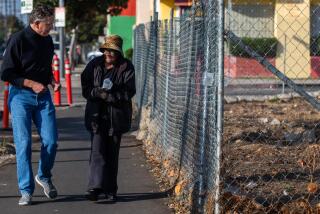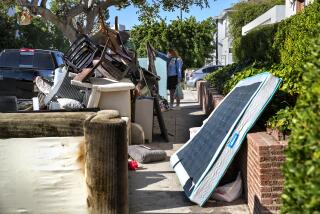Group Calls Dumping a Dirty Deal : Pierce College: School says it needs the $2.1 million it will get to accept soil from Warner Ridge. Protesters fear the project will lead to development.
- Share via
This is a story about dirt.
Not dishing dirt, like the characters in the never-ending tale of alleged madam Heidi Fleiss; not the kind of dirt that frustrates perfectly coiffed mothers on TV commercials; but plain old dirt.
Thirty-thousand truckloads of it, to be excavated from the site of the Warner Ridge Development in Woodland Hills. Pierce College operates a 240-acre farm and has agreed to accept the dirt from Warner Ridge. The college, which plans to use the dirt to help stop a drainage problem in the hills behind its farm, will be paid $2.1 million for taking it off the developer’s hands.
But a coalition of homeowner, environmental and agricultural groups--most of which also vehemently oppose the development--has vowed to stop the deal, saying it could be the first step toward developing the land.
On Saturday, about 90 members of the Coalition to Save Pierce Farm--many holding signs that said “Just say Whoa to dirt”--staged a noisy demonstration outside the college grounds.
“We want to show the trustees and the Pierce administration how many people are opposed to using the college farm as a landfill,” said Margo Murman, president of the coalition.
Dumping the dirt on the hills could harm an area of the campus used as a winter habitat for Canada geese, Murman said, or cause mudslides during the rainy season.
“Eventually, they’ll realize that it won’t grow anything,” said Paul Perrotta of North Hills, referring to the land to be filled. He brandished a “Honk if you love geese” sign.
“They’ll sell it and put buildings on it,” Perrotta said.
Pierce College President Lowell Erickson said Friday that the college desperately needs the $2.1 million the dirt deal could generate.
“When it comes to money, Pierce is $1.3 million out of balance right now, and I know of no other source for that funding,” Erickson said. The money would be used, he said, to restore classes that had been cut from the college’s fall schedule.
Under the college’s plan, the dirt--420,000 cubic yards altogether--would be dumped on a 42-acre section of land that is currently used for grazing cattle and sheep. The topsoil covering the area would be removed, the fill dirt applied and graded into new hills. Then the topsoil would be replaced. New grasses and trees would be planted.
According to an environmental impact report released Friday, the biggest effect of the project would be noise and dust. The report downplayed the possibility of significant environmental damage, but recommended that the project be completed by November in order to minimize the impact on Canada geese who feed there in winter.
Bob Gross, president of the Woodland Hills Homeowners Assn., criticized the report, saying it did not take into consideration his organization’s response to an earlier draft version of it. He and other opponents of the plan said it’s not possible to get the dirt graded, covered with topsoil and grasses grown by the time the geese show up in late fall.
But mostly, opponents say, they’re just darn wary of all that dirt.
“They’re experimenting with this public land,” said Eric Lesser, chairman of the Sierra Club’s San Fernando Valley group. “They keep tinkering, doing these little projects here and there, and eventually the net result is the loss of this civic resource.”
More to Read
Sign up for Essential California
The most important California stories and recommendations in your inbox every morning.
You may occasionally receive promotional content from the Los Angeles Times.













